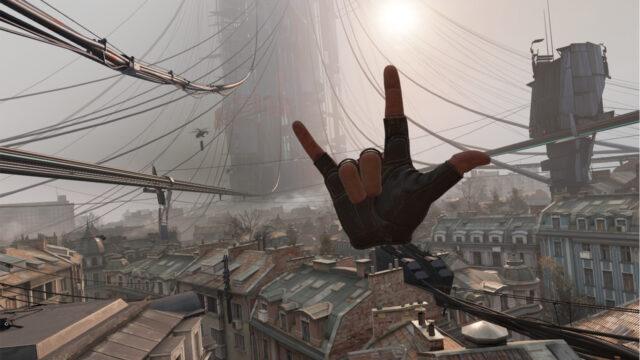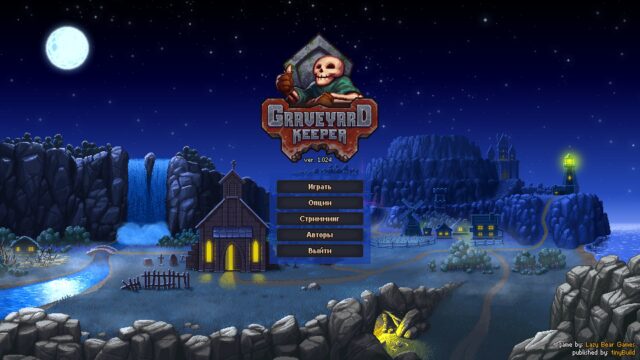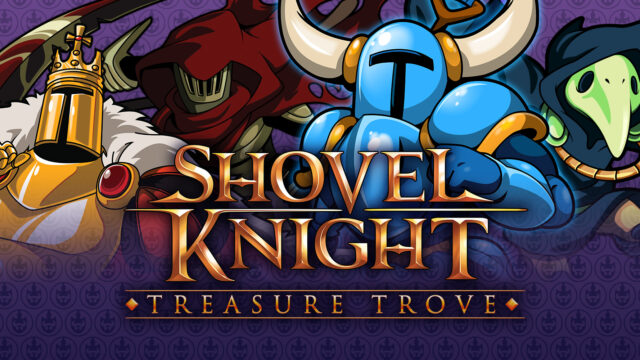Bioshock: Infinite Review
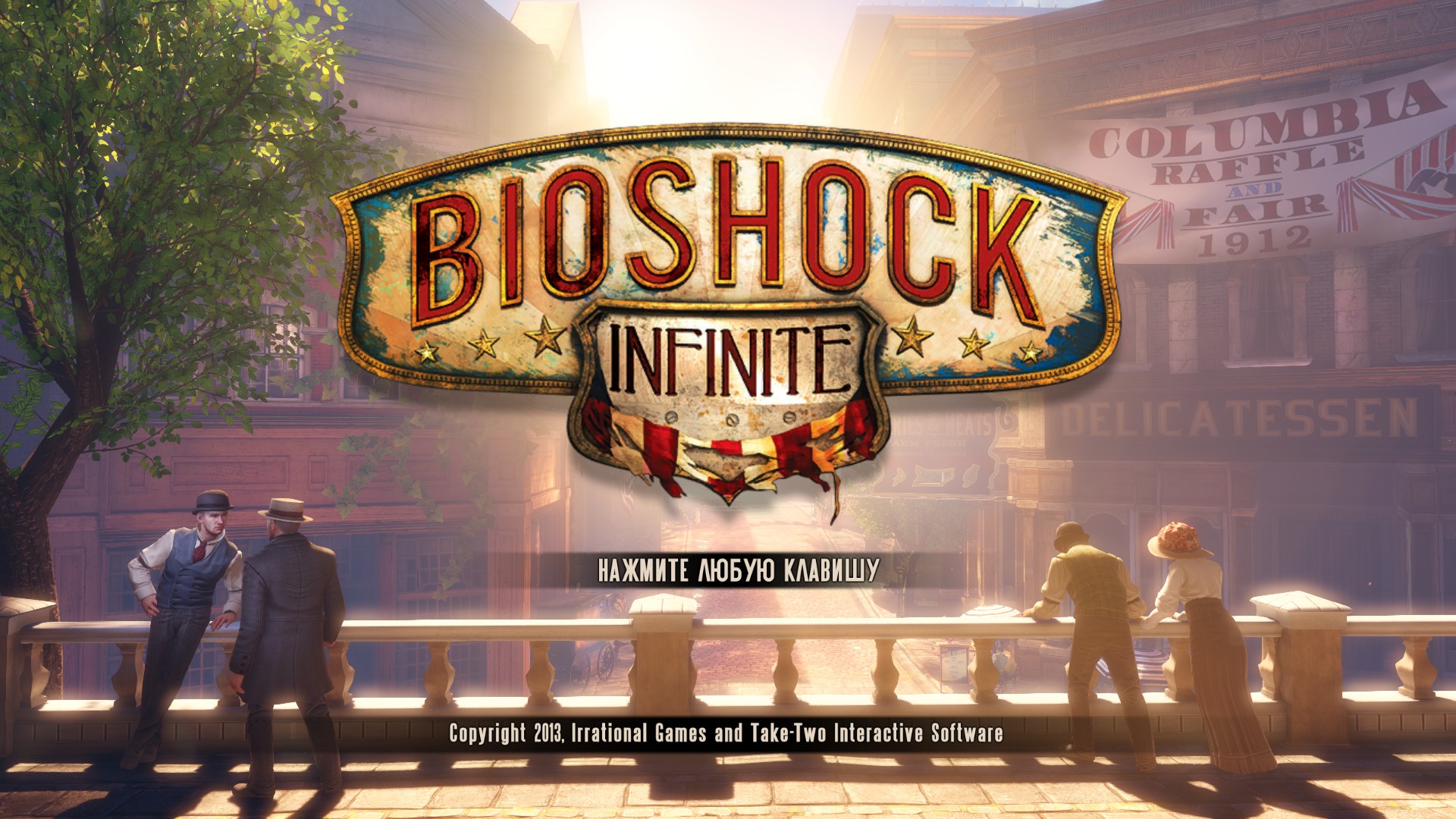
Bioshock: Infinite is a well-disguised Japanese RPG.
Ahead is a lighthouse, and it is clear that swimming somewhere in the storm is not an option, but you can enter this dock shed to find one dollar there. And maybe an apple. Well, then – 20 minutes of contemplating the background.
At the very beginning, along with photographs of Elizabeth, her gingerbread house, and some cipher (you don’t have to remember it), they give us a gun, but then quickly take it away because you want to start shooting from the moment you arrive in Columbia.
Aaa, clone-sectarians!
But the monkey has already had its grenade taken away, which makes you look closely at things. And it seems that, in fact, we are not being greeted by clone-sectarians, but simply sectarians. After some time, it becomes obvious that the town is not only that, but also blatantly racist, but that’s later, for now, we are being led through a pipe to the fair.
Along the way, returning the old grenade to the monkey and giving out new ones.

The fattest enemy in the game. Aim for the heart, beware of jumps.
What the prologue is about:
At the beginning of the last century, there lived Booker DeWitt, a war veteran of the hairy year, who owed people whom, according to his own words, he shouldn’t have gotten into debt with. These very creditors sent Booker deep into enemy territory to kidnap Elizabeth.
And that’s it. Ahead is the lighthouse.
If you are interested in unraveling the plot before it is spoon-fed to you, pay special attention to everything that happens before you retrieve the lucky lottery baseball. Walk through dead ends, feast on scattered food everywhere (don’t forget to check the trash cans!), listen to what people are saying around you – and almost all the historical knots of Bioshock: Infinite will become very clear.
Or it will always seem that way, and that’s why the game will manage to surprise you quite a few times. It will happen once at the very end, naturally.

Shooter – it’s like, in B:I it exists and it’s overall not bad, but our game – it’s about a girl-heroine and about the city. That one, no words, beautiful, especially until they start rolling us through the slums that are mandatory in every video game urban excursion. The clouds get annoying quickly, though, but the feeling that you’re running around a “city on air balloons” and it’s insanely cool, never leaves.
Even when things get heated on a racial-class-religious basis. They stuffed all sorts of things into the plot; here it is, the advantage of video games over movies! You will never – hear me – never be able to cram so much nonsense into one big project, even if it’s the Lost series.
The translation, though, sometimes hinders immersion and tries to confuse. You have a telegram! Don’t shoot the pianist STOP He plays as he can STOP. Well, it’s a period, a period, DOT, how can you not notice it, even without looking, what this piece of text is sticking to?

Don’t mind that they only run with clubs. Those guys hit hard.
And yet Bioshock: Infinite is a first-person shooter, and no matter how much we want to enjoy the beauty and various views during the 10 hours of gameplay, there will be a lot of shooting. In other words, the third part of the series has finally become a more or less real FPS, where there are truly many enemies and guns, where you have to run around the battlefield in search of ammo and mow down ordinary soldiers in packs.
The magic is still there, but now it’s optional like never before. Even on the Hard difficulty level, you can practically shoot everyone without using any tricks, except maybe for rare cyborgs with a flaming motor in place of their heart.
Plus, Elizabeth, among other things, will regularly supply Booker with ammo. Oh, yes, Elizabeth. You’ve probably heard about her. And seen her, seen her many times in videos, pictures, cosplay events (and just on the internet), everywhere it was possible.
And here the focus of surpassing B:I in terms of release and therefore taking the palm of victory from Tomb Raider starts working at full speed. If you’re not aware yet, it turns out that in order for gamers to be amazed and have rainbows pouring out of their eyes when they see a girl in a video game, you need to stop giving her a bust of a size ten, dress her somewhat more humanly – without armor on her bare body – and remove the most obvious hints at it.

The essence of Bioshock Infinite in one screenshot.
All, the breakthrough of character development in 2013 is done, the revolution is accomplished, everyone is happy.
So, Elizabeth is young, beautiful, probably smart, and has spent her whole life in a high tower, where evil uncles and aunts secretly took questionable photos of her. She loves dancing, Paris, doesn’t easily succumb to hysteria, shoots bullets, heals serious wounds, and picks locks.
No, she really turned out lovely, but, to be honest, I can’t seem to squeeze out the usual level of adoration for Lara and now Elizabeth. It’s strange to be charmed by the fact that we can sometimes have fun not only with rubber dolls but also with relatively believable girl characters. Mind-blowing achievement.
With everything else, it’s exactly the same. The game is great, but in response to the party leadership’s request to “give it a ten,” I have to honestly answer, “I won’t give more than an eight.”
Bioshock: Infinite is an excellent FPS, no reservations, even though it’s a Japanese role-playing game. The gameplay is solid, they hide the Tube well, there are some relatively fresh moments like riding on a monorail with a hook, the shooting is repetitive, but when it gets boring, you can always start throwing fireballs. There are no decent bosses, though, but it doesn’t matter because here we’re not so much looking through the scope as we are searching the corners for some interesting piece of the world, an Easter egg, or another semi-secret room in the castle.
With all that said, well, no, there’s nothing outstanding enough in the new “Bioshock” to give it that perfect score. Don’t point fingers at Elizabeth, don’t point fingers at the plot twist. Everything is great, we knew it and better.
You must definitely play B:I. It’s interesting, atmospheric, and short.
But this game is not of the caliber to claim something greater, according to the scoring system or any other.
BioShock Infinite: Clash in the Clouds
First and foremost: this is not the new story for BioShock Infinite that you may have hoped for. This add-on will be released in two parts, the first of which is called Burial at Sea and will be released this year. All your dreams will come true there: Booker – a private detective, Elizabeth – a lady with problems, these two have not met before, and by the way, did I mention that the action will take place in the underwater city of Rapture, even before its downfall? It’s so nice to realize that I’m not making it up at all.
But for now, we have to settle for the five-dollar Clash in the Clouds – the fact of its release already speaks of some attention to the fans, but the essence of the DLC is a set of challenges that play on the best aspects of Infinite’s combat, unrelated to the original game except for the appearance and mechanics. If the battles in BioShock Infinite caused you more anxiety than pleasure, it’s better to just watch the secret places on YouTube. And me? I loved the fights in Infinite, so this add-on is right up my alley.
Clash in the Clouds is an arena mode with waves of enemies, where Booker and Elizabeth – not as talkative as before – will face hellish combinations of enemies on four maps stitched together from familiar areas of the city of Columbia. By killing enemies in original ways, you earn points and money. Points display your position on the leaderboard, and money is spent on weapons and vigor upgrades in the intermediate zone between waves.

If this sounds too easy, then there are bonus challenges for you with additional objectives for each wave. For example, killing enemies within a certain time or without taking damage, or using only specific weapons or vigors, or only through a sniper scope. These challenges are not mandatory, but they give you bonuses and blue ribbons that hang on the wall in the intermediate zone.
What’s more important is that you will have to use different weapons and vigors than you may be accustomed to in BioShock Infinite. When the tension rises in the original game, it’s hard not to resort to foolproof combinations like shotgun and Shock Jockey or Murder of Crows and hand cannon. In Clash in the Clouds, the bonus challenges encourage you to experiment: luring enemies to the edges to drop them with Undertow, or leading them into crow and fire traps. There are 15 waves on each map, and you don’t have many attempts to earn the reward.
The first arena, Ops Zeal, is the easiest. In Clash in the Clouds, you have access to the entire arsenal right away, and the first enemies are dumb enough to make the beginning easy. One of the challenges requires attacking only with the Sky-Hook, another requires killing enemies only with the hand cannon or pistol, and as you circle around the arena, blowing brains out and throwing vigors, you’re actually just playing with your food. Turns out, mom only forbade you from playing with your food at the table because it’s wildly fun.
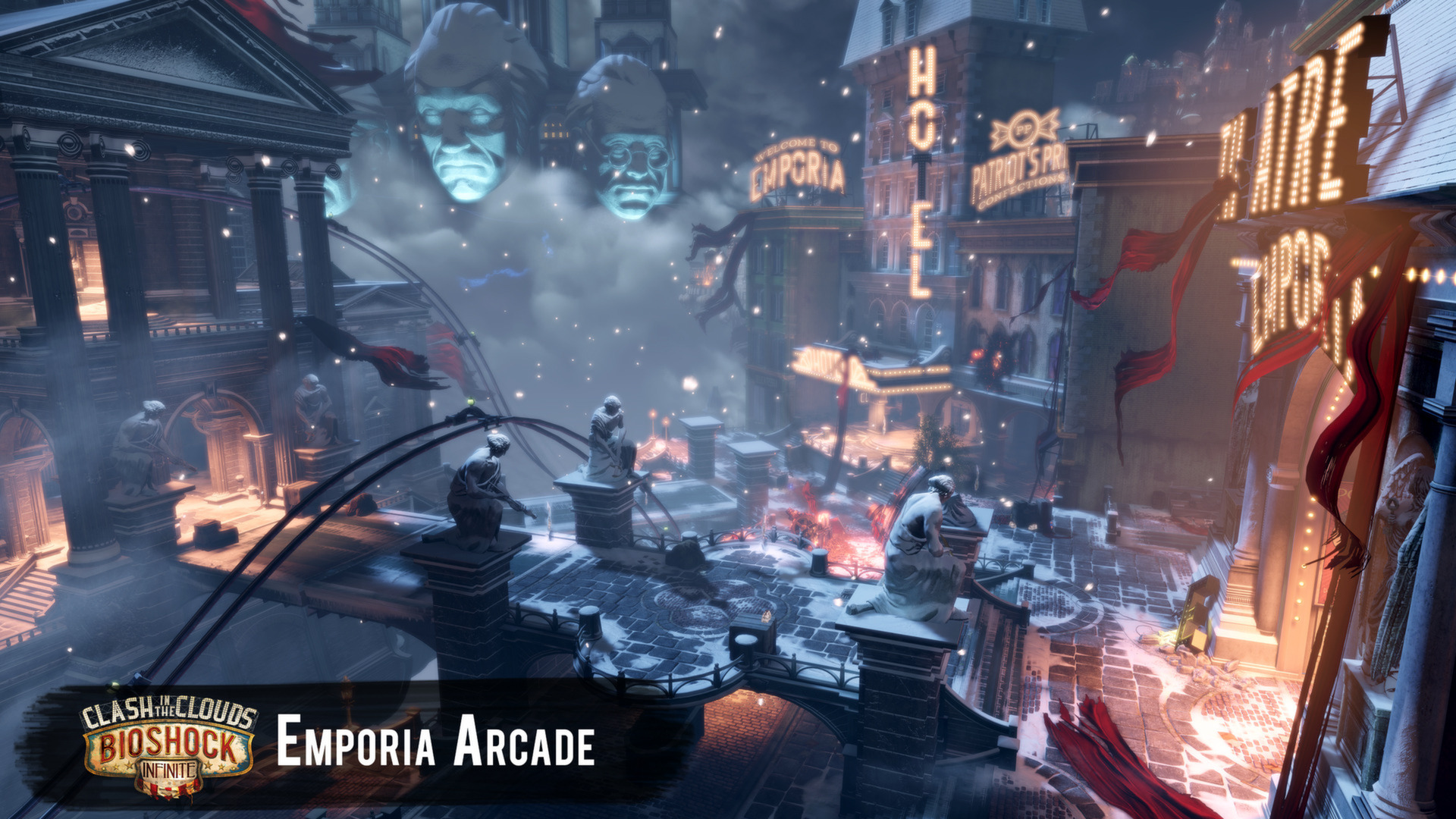
Emporia Arcade offers us powerful streets, delighting with impressive sizes and a variety of routes, however, an easy life is not to be seen here – especially with the Mechanics and Firefighters.
In Ops Zeal, everything is easily achievable, unlike the other three maps, which are more extensive and complex. Duke and Dimwit Theatre takes you to Soldier’s Field – a recreational area where we visited the Hall of Heroes; Raven’s Dome is more like the Lottery Park from the very beginning of the game; Emporia Arcade represents a crumbling wealthy district. Each map has its own merits, but they are all too convoluted, making it difficult to keep track of enemy movements while jumping through gaps, sliding on rails, and juggling hotkeys.
Furthermore, their difficulty is higher in and of itself. The goal of Clash in the Clouds is to present players with tough challenges (apparently, many people enjoyed the hellish 1999 mode from Infinite), and here they are not shy about killing you quickly and frequently. After death, you can continue with a loss of points, return to the first wave, or move to an intermediate zone.
You can avoid death by spending a little money and activating a respawn point in the middle of the level, and the game kindly allows you to keep all your cash in case of failure. Nevertheless, it remains challenging, and as I get closer to the final waves, I often forget about additional tasks and creative tactics, struggling to break through the enemies.

The hall of the Colombian Archaeological Society is a true paradise for fans, however, if you want to fully immerse yourself in the talent of the creators, flip through the artbook.
Clash in the Clouds is worth investing a little perseverance in completing. The accumulated money can be spent on a variety of treats in the intermediate zone. Here is the hall of the Colombian Archaeological Society, where you can uncover statues of characters, recordings of ancient, suspiciously familiar melodies by Albert Fink, concept art with sketches of airships and battles, and kinetoscope recordings with very interesting information for Infinite fans. There are also secrets here that are not difficult to discover and that will be the final element of the narrative before we descend back to Rapture.
Of course, it’s nice to realize that we have something to look forward to, but this puts Clash in the Clouds in an awkward position. I wouldn’t be surprised if the DLC evokes mixed feelings or even negativity in many people. Some will enjoy the addition with a focus on the most interesting aspects of BioShock Infinite’s combat system, but even all the kinetoscopes and concept art of the world will not satisfy fans who are waiting for a continuation of the story – and they may think that it is exactly what has been released.
Even without considering unjustified hopes, the add-on may not appeal to everyone. It has a very attractive price, and if you think you have mastered BioShock Infinite skillfully and are eager for new challenges, then this is a great reason to return to the game for a long time. But if at first I liked everything, I jumped around the arenas, trying different approaches and collecting blue ribbons, then towards the end I was too exhausted for experiments and played on autopilot just to unlock something new.
It’s a pity that the designers failed to keep all the arenas casual enough for those players who just want to try out all the creative elements of combat, like in the early waves of Ops Zeal. Instead, the balance quickly shifts towards difficulty, and Clash in the Clouds becomes another hardcore mode. This is also not bad, but the DLC had the potential to bring to the surface all the richness of BioShock Infinite’s combat and wrap it in a series of reckless challenges. The emphasis on hardcore looks like a limited interpretation of what this aspect of the game is really good at.
But, in my opinion, it will do as an appetizer, even though I could just as well not touch the add-on and calmly immerse myself in the no longer so long wait for Burial at Sea.
BioShock Infinite: Burial at Sea – Episode One
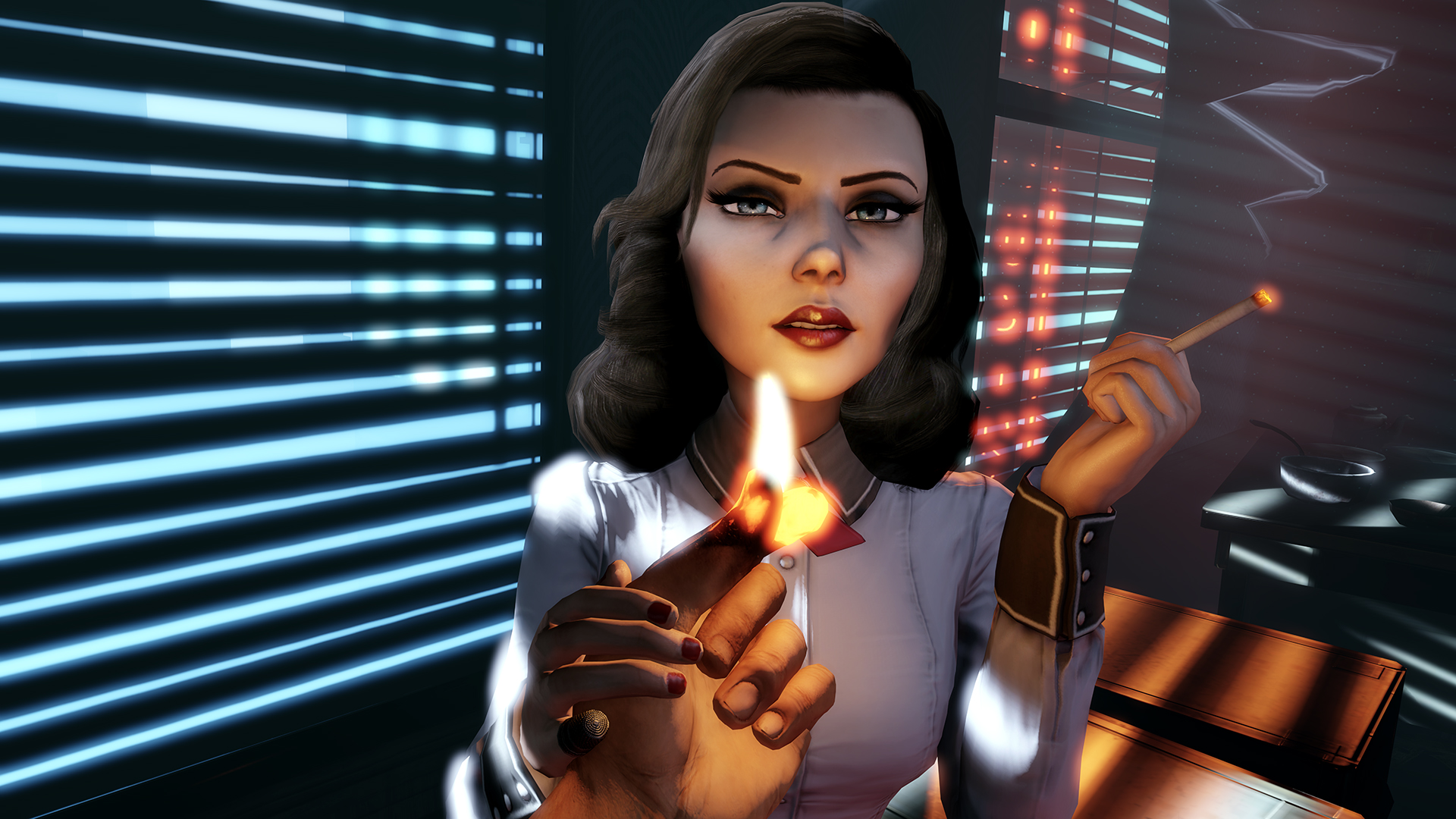
Constants and variables. The first story add-on to Bioshock Infinite has done a stunning job in creating a vibrant and memorable story, based on the same concepts. The guys from Irrational had a lot of fun, taking familiar characters and transporting them to a place and time we could only dream of – Rapture, the underwater city from the first two Bioshock games, before its catastrophic downfall.
It was intriguing to see Booker and Elizabeth from Infinite again, who seem like strangers but are still inseparably connected. It was exciting to guide them through places they are connected to but do not belong to. During the half-hour introduction, Irrational showers us with references to the most memorable themes, locations, and characters of Rapture, skillfully twisting variables around numerous constants.
Furthermore, this introduction serves to show the myriad moments where Rapture contrasts with the heavenly Columbia: from the oppressive darkness of the horizon to the false freedom of societal ideals, from Booker’s transformation into one of Rapture’s inhabitants to Elizabeth waltzing through his office and engaging in cynical conversations about work and money – but then rushing to the front lines without hiding behind a strong male back. As constants and variables converge once again, one simply wants to lean back in their chair and enthusiastically observe how the threads of the story weave a luxurious tale.
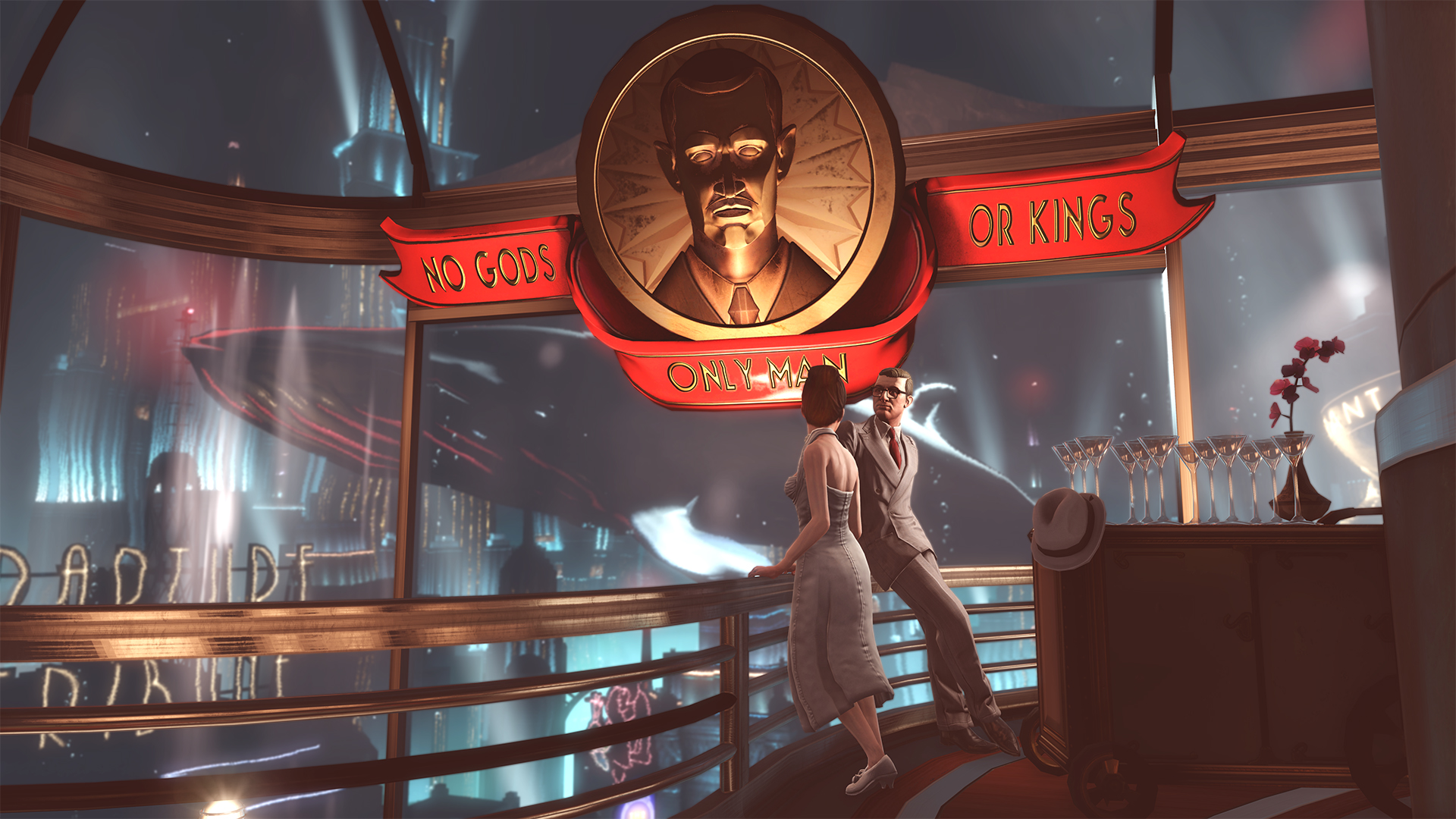
These thirty minutes are very important because they will greatly influence whether you will enjoy Burial at Sea or not. If you don’t regret spending time to taste the atmosphere and charm of Rapture, then Irrational has a lot in store for you that will make you smile. It feels like some kind of spectacular show that is put on just for you. It wants you to relax and acknowledge that Rapture is not as real as it seems at first glance. The city’s residents will stand in their places and wait for you to approach them, and then they start reciting a rehearsed monologue/dialogue. The Houdini-waiter intentionally blocks your path so you can admire his magical tricks. Your freedom of movement is limited by technical maintenance, necessary facilities, and simply by the waiters who refuse to let you into the hotel where you once had a smoke.
This is Rapture that resembles a museum exhibit. It inspires, evokes memories, and some semi-sacred feelings, but it is fenced off from you with a beautiful chain and bulletproof glass. “Do not touch with hands.” Well, or touch, but just a little bit. However, the introduction is coming to an end very soon. You find a key, unlock the door, and set off in search of the girl Sally – the “Glory to Rapture” tour is coming to an end. You may have expected something more, so when transitioning from one level to another, Irrational warns you that after you step over the threshold to see a familiar face again, there will be no way back. The tour ends here, follow the arrows to the exit, re-entry is prohibited.
Beyond this point, Booker and Elizabeth delve into the depths of Rapture, where its former residents – now splicers – roam the abandoned shopping center, where there is little light and many skinny drain pipes. This is the old Rapture, the shadow of the city that looms over it – we have already seen it before in the distant year of 2007. It is here that Burial at Sea, in fact, begins.
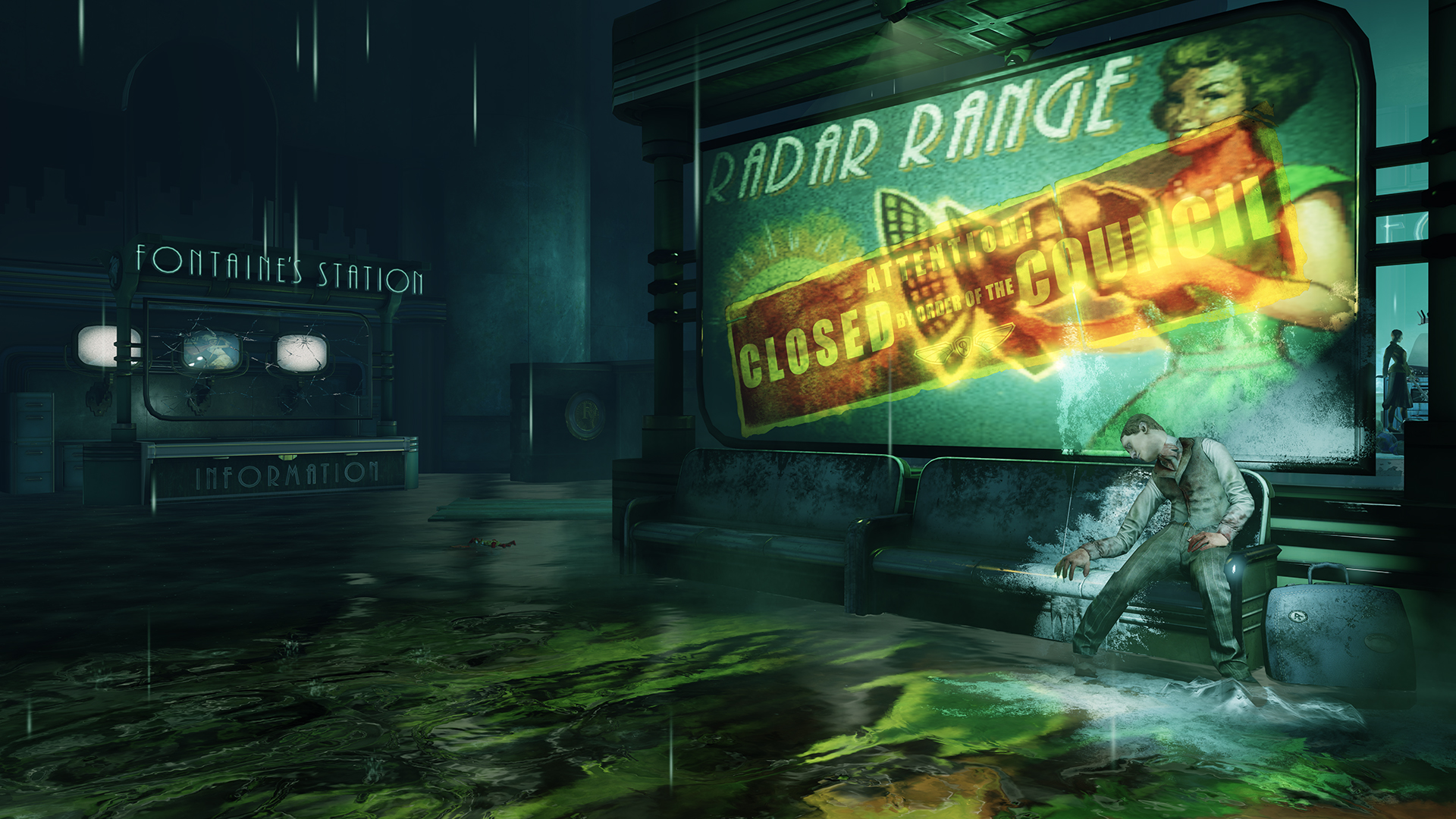
The search for Sally leads through the halls and rooms that once belonged to Frank Fontaine, who clashed with Andrew Ryan, the creator of Rapture – the trading center that ended up buried at the bottom of the sea, becoming a victim of fierce competition. Here, the characters return to familiar relationships – Elizabeth often stays behind the scenes, while Booker, wielding carbines and vigors (here they are called “drinking plasmids” for reasons explained in one of Dr. Suchong’s audio diaries), takes the initiative.
At first, Booker only has two vigors – “Devil’s Kiss” and “Hypnotize” – and there is a constant shortage of ammunition, which forces him to carefully consider his actions. The game requires you to set traps (an alternative use of vigors) and pick off splicers one by one, rather than rushing into the thick of battle and opening fire. Elizabeth can still provide additional ammo or health packs, but the overall lack of resources and scarcity of trash cans to rummage through is a clear sign that the player is encouraged to take a more cautious approach.
This interesting change in the pace of combat makes the battles more significant. Sometimes you have to fend off a pack of splicers in order to acquire a new plasmid or while Elizabeth tries to pick a lock – the resource shortage adds a sense of tension and relief once the fight is over.
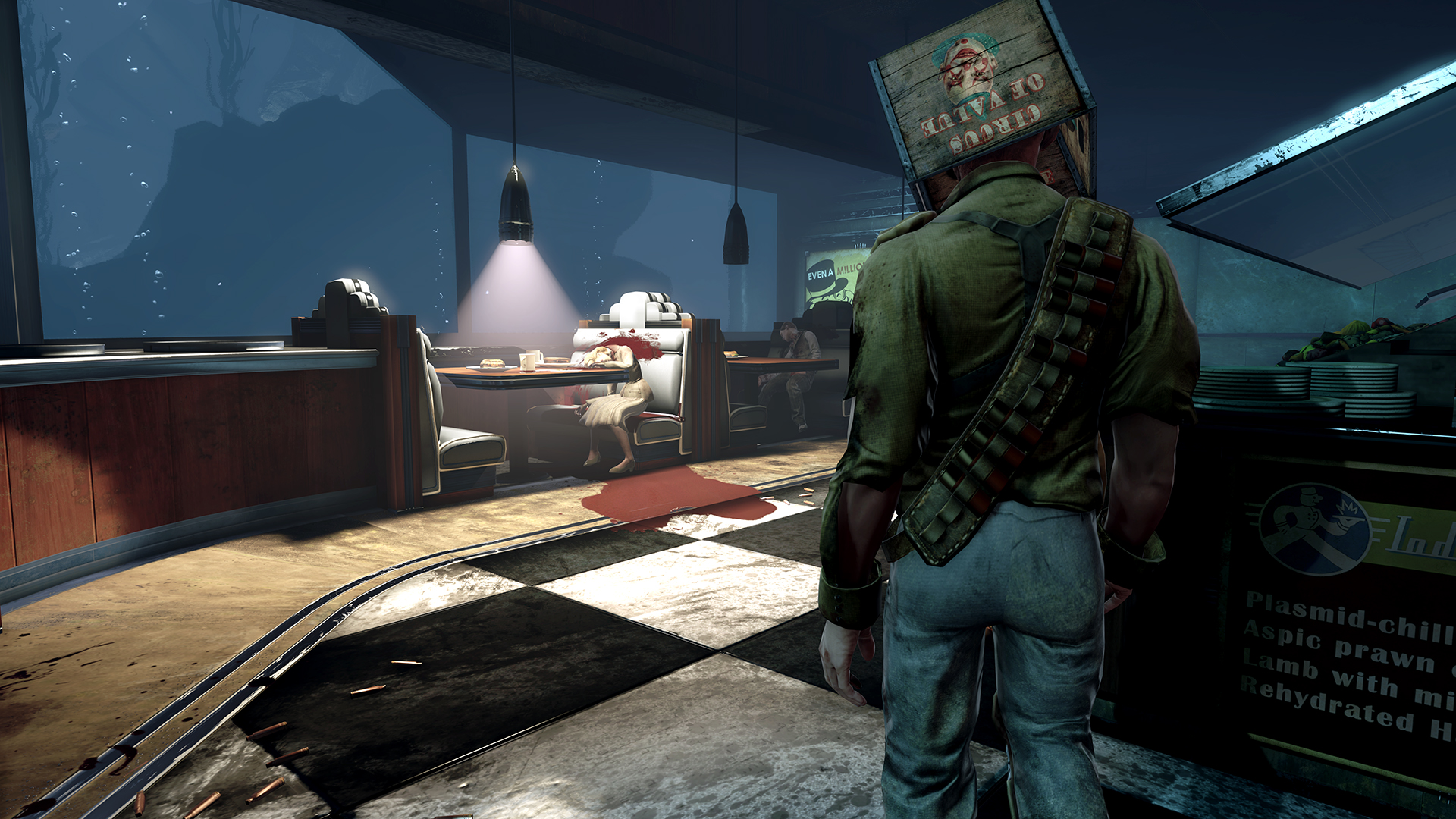
In the depths of the relationship between Booker and Elizabeth, their interactions are mostly functional, but beneath this surface, something intriguing occasionally shines through. Elizabeth is cold towards Booker, and their relationship remains formal. If the game needs to evoke any emotions in you, Elizabeth does so reluctantly, with impatience and sarcastic sharpness, which replace what we remember from the events in Colombia. It’s not surprising that everything is much deeper than it seems at first, the strokes made by the game continue to itch in your mind, which tries to piece together the mosaic to unravel the mystery of Elizabeth and what the actions of this mysterious couple will ultimately lead to.
Unfortunately, the gameplay cannot boast the same depth – it can be reduced to visiting a couple of locations and pressing a few buttons. And although the objectives can be completed in any order, the game feels linear from beginning to end. Of course, the same can be said about all the missions in Bioshock, but here the overall compression of impressions exposes the corridor essence of the game like never before.
Content for the sake of content is counterproductive and destructive to the overall quality, but the degree of diversity in objectives can only be welcomed. While some main objectives can be justified by the plot, the decisions made by the characters sometimes make no sense. Moreover, this does not excuse Irrational, which introduced several overly contrived and completely unnecessary elements.
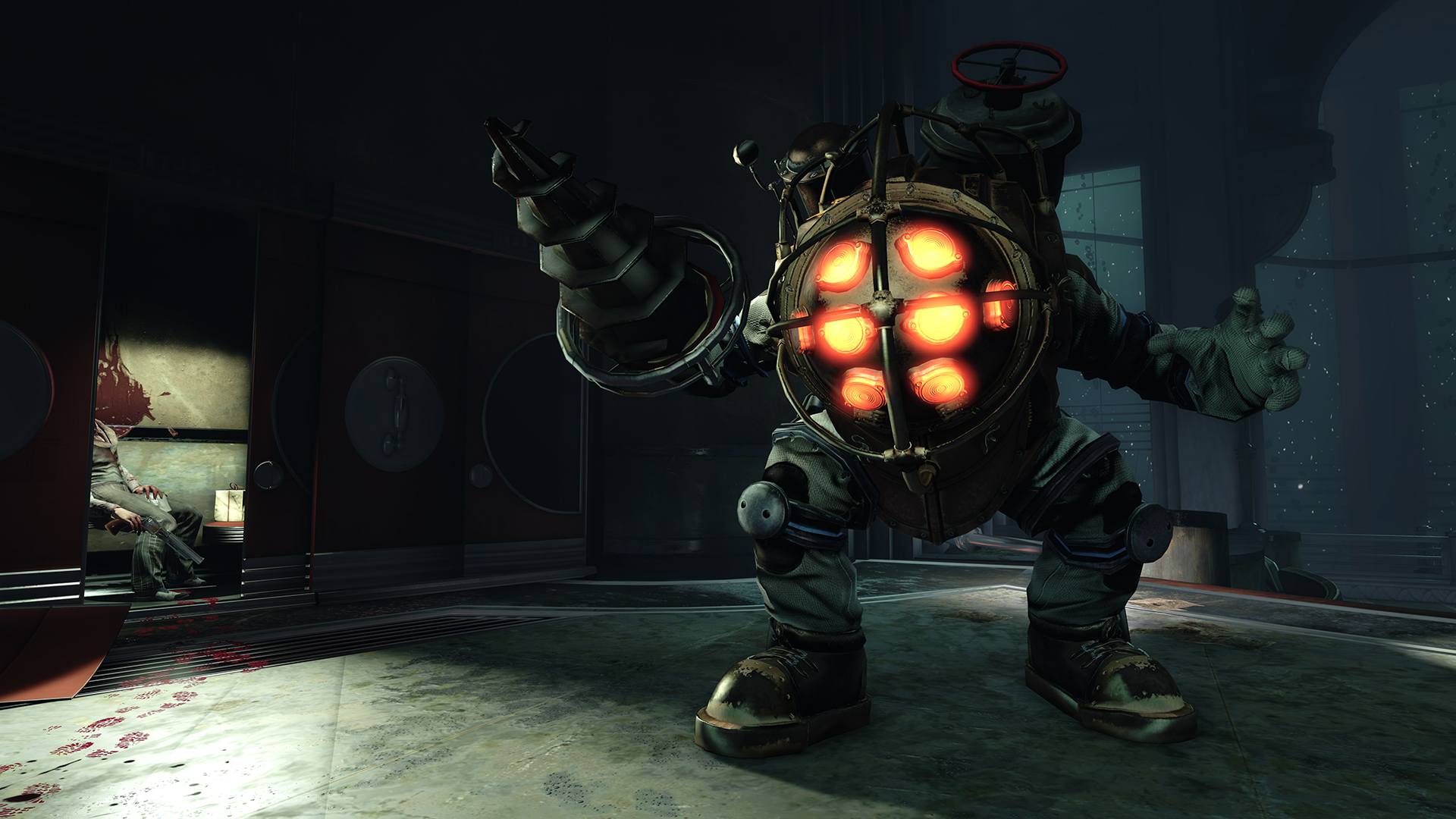
They seem as if they were forcibly squeezed into the add-on to further connect Burial at Sea and Bioshock Infinite. For example, the renamed skyhook, which is used only two or three times, or the gear system for selecting weapons and plasmids, which seems as out of place in Rapture as it did in Columbia. Elizabeth’s ability to open portals is presented well, though with a knowing wink.
The first episode of Burial at Sea is based on so many constants and variables that it will undoubtedly cause some disagreements. It seems too short, even being one of the halves of a 2-act story, but it gives us a luxurious plot that leads to a stunning climax. The price of $8 seems too high, especially since there is little desire to replay it, but its production value surpasses some full-fledged games. It lacks diversity, but it has quality. There is something to think about here, but almost nothing to do.
And, of course, it brings us back to Rapture – one of the most convincing and captivating gaming universes, where we can draw parallels between the past and the future, and then, by connecting different plot points together, feel like a true genius. The amount of time and attention you invest in Irrational’s creation will ultimately determine how much you get out of this small add-on.
Share
Discuss
More Reviews

